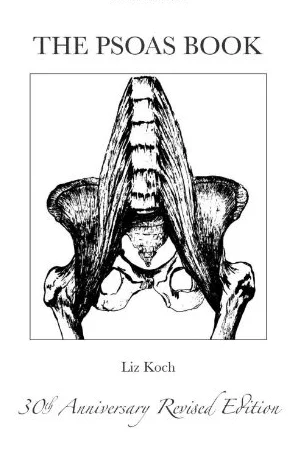Books

The Psoas is NOT a Hip Flexor
The psoas is not a hip flexor – okay, there I have said it! Usually I warm my students to this idea before I spring it on them. However, I guess I am feeling bold. Whether or not you agree with me that the psoas is something other then a flexor muscle, I invite you to test out my reasoning during your next practice.
Buy The Psoas Book by Liz Koch on Amazon.
The iliopsoas, fondly known as psoas (so-as), is the core muscle of the body and it is the only muscle to attach spine to leg. The psoas is formally categorized as a hip flexor. Flexors are defined as muscles that close a joint. Major flexors are located in the front of the body. Because the psoas moves from the deepest core at the 12th thoracic (or 1st lumbar) vertebrae diagonally forward through the front of the body and over the hip sockets and then back into the lesser trocanter of the femur, it is classified as a hip flexor. This is the biomechanical story, however, there is another story. This other story is embryonic; it is the story of how human life begins and develops in utero. It tells a story about an essential midline called the primitive streak from which everything emerges. Within this paradigm the psoas grows out of the human midline and is a messenger of the central nervous system; integral to primary reflexes, neurological proprioception, and personal integrity.
Even within the biomechanical model, it is worth noting that the psoas exerts an eccentric contraction, which is a confusing way of saying that the psoas doesn’t shorten. Rather it falls back along the spine while lifting the legs, bringing knee to chest, curling the spine, or bending at the hips. During walking, the psoas moves like a pendulum through the core maintaining its full length as the leg swings forward and back.
Buy The Psoas Book by Liz Koch on Amazon.
The main reason why I believe redefining the psoas is so important is due to our behavior. If we think of this tissue as a muscle flexor then we will proceed in trying to stretch and strengthen it as we would any other flexor. However, if we think of the psoas primarily as neurological information, tender, supple, bio-intelligent tissue, we begin listening to it and recognizing it as a vital messenger. Although engaging the lower psoas as a flexor is definitely possible, doing so interferes with experiencing a deep, profound relaxation or neutrality within the core. Psoas muscles are not weak they are exhausted. Ultimately it is a responsive psoas that helps free the hip flexors to function with just the right amount of exertion.
Test out my reasoning by starting your practice with constructive rest. On your back, knees up, feet on the floor, (the width apart of your hip sockets). This rest position lets gravity release tension from your psoas. Roll to your side and get up slowly, take your time to sense the shifts and changes in weight through muscles, tendons and bones. Prepare for performing a runners lunge on the reformer. When ready, notice how simply imaging your psoas neutral, rather than engaged (in both your hips), allows a deeper relaxation, which enhances your sense of skeletal weight. There is a major artery (and vein) directly on top of the lower psoas, thus a deeper sensation of relaxation in the psoas allows for increased blood circulation within the hip socket, pelvis, and leg. Experiment in the same way while in the C curl. It does not matter what direction the spine is moving, the psoas is responsive tissue, branching out, and sending proprioceptive information. The spine or embryonic midline is always neutral – your core is the eye of the storm and your inner sanctuary does not react to every push or pull from external muscles, or life’s external demands for that matter.
It takes a quality of discernment to differentiate the psoas from the hip flexors. If the quads are over developed or the tendons of the hip flexors excessively tense, it is necessary to first soften. However once you do, I believe you will be amazed at what a paradigm shift can do to bring a deeper sense of and responsiveness from your sweet psoas.
For those who already sense their lower psoas soft and responsive, include your upper psoas by lifting one arm (on the same side as the straight thigh or in advanced lunges, the leg that is behind the pelvic basin), and place your hand on your head, turning slightly, look up towards your floating elbow. Psoas tissue moves spatially 360 degrees, but only when free to do so. Sensing your whole psoas spreading down towards the platform (earth) and freely up towards your heart (heaven) is simultaneously a feeling of fullness and emptiness. Experiencing complete core relaxation awakens a profound connection to breath and your heart’s desire.
The psoas is juicy, supple, and dynamic: a major player in full body orgasms. It is the filet mignon, the finest cut of meat humans eat in other animals. Chefs tell me the psoas tissue is a different color, texture, and quality from any other muscle meat. This gets me thinking that perhaps the psoas is more like the tongue, an organ of perception… maybe it isn’t even a muscle!




